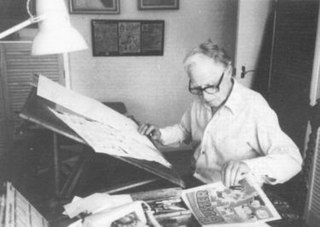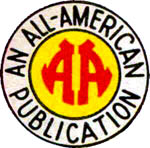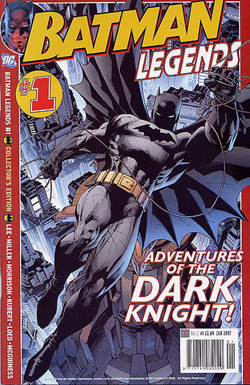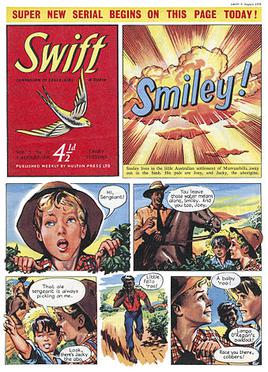
Timely Comics is the common name for the group of corporations that was the earliest comic book arm of American publisher Martin Goodman, and the entity that would evolve by the 1960s to become Marvel Comics.

Radio Fun was a British celebrity comics comic paper that ran from 15 October 1938 to 18 February 1961, when it became the first out of twelve titles to merge with Buster.

All Star Comics is an American comic book series from All-American Publications, one of three companies that merged with National Periodical Publications to form the modern-day DC Comics. While the series' cover-logo trademark reads All Star Comics, its copyrighted title as indicated by postal indicia is All-Star Comics, with a hyphen. With the exception of the first two issues, All Star Comics told stories about the adventures of the Justice Society of America, the first team of superheroes. It also introduced Wonder Woman.

Reginald Edward Parlett was an artist from England who had a career of drawing for comic books that lasted for 66 years.
The Amalgamated Press (AP) was a British newspaper and magazine publishing company founded by journalist and entrepreneur Alfred Harmsworth (1865–1922) in 1901, gathering his many publishing ventures together under one banner. At one point the largest publishing company in the world, AP employed writers such as Arthur Mee, John Alexander Hammerton, Edwy Searles Brooks, and Charles Hamilton. Its subsidiary, the Educational Book Company, published The Harmsworth Self-Educator, The Children's Encyclopædia, and Harmsworth's Universal Encyclopaedia. The company's newspapers included the Daily Mail, the Daily Mirror, The Evening News, The Observer, and The Times. At its height, AP published over 70 magazines and operated three large printing works and paper mills in South London.
Michael Anglo was a British comic book writer, editor and artist, as well as an author. He was best known for creating the superhero Marvelman, later known as Miracleman.
Jack and Jill was a British children's comics magazine published by Amalgamated Press/Fleetway/IPC between 27 February 1954 and 29 June 1985, a run of approximately 1,640 issues. In 1955, Jack and Jill absorbed the fellow Amalgamated Press title Playbox.

Valiant was a weekly British comics periodical published by Fleetway Publications and later IPC Magazines from 4 October 1962 to 16 October 1976. A boys' adventure comic, it debuted numerous memorable characters, including Captain Hurricane, The Steel Claw and Mytek the Mighty. Valiant lasted for 712 issues before being merged with stablemate Battle Picture Weekly.

All-American Publications, Inc. was one of two American comic book companies that merged to form the modern-day DC Comics, one of the two largest publishers of comic books in the United States. Superheroes created for All-American include the original Atom, Flash, Green Lantern, Hawkman, and Wonder Woman, all in the 1940s' Golden Age of Comic Books.
The Holyoke Publishing Company was an American magazine and comic-book publisher with offices in Holyoke, and Springfield, Massachusetts, and New York City, Its best-known comics characters were Blue Beetle and the superhero duo Cat-Man and Kitten, all inherited from defunct former clients of Holyoke's printing business.
Playhour was a British children's comics magazine published by Amalgamated Press/Fleetway/IPC between 16 October 1954 and 15 August 1987, a run of approximately 1,700 weekly issues. Playhour contained a mixture of original tales for young children and adaptations of well-known fairy tales.

Smash! was a weekly British comic book, published initially by Odhams Press and subsequently by IPC Magazines, from 5 February 1966 to 3 April 1971. After 257 issues it merged into Valiant.

Batman Legends was a monthly anthology comic book series published in the UK by Titan Magazines as part of their DC Comics 'Collector's' Edition' range. Initially published by Panini Comics for 41 issues between October 2003 and November 2006, Titan subsequently took over publication with the launch of the comic's second volume. The title reprinted Batman-related comics originally published by DC Comics in the United States, typically including three stories per issue in a serialised format.
Super Duck was a comic book character created in 1943 for what was then MLJ Comics by staff artist Al Fagaly. As his name implies, Super Duck was originally a parody of Superman, even down to a red and blue costume. But his time as a superhero was short, and by late 1944 his stories became more conventional, in the Disney/Carl Barks mode.

Swift was a British weekly comics magazine published by in the UK as a junior companion to the Eagle.
Frederick Thomas (Freddie) Adkins was a British comics artist who worked for the Amalgamated Press from the 1920s to the 1950s.
Denis Gifford was a prolific comic artist and writer, most active in the 1940s, 50s and 60s. Gifford's work was largely of humour strips in British comics, often for L. Miller & Son. He was an influential comics historian, particularly of British comics from the 19th century to the 1940s.
Frank Z. Temerson (1890–1963) was a comic book publisher from the Golden Age of Comic Books. Temerson's imprints included Ultem Publications, Helnit Publishing, Et-Es-Go Magazines, and Continental Magazines.
Charlie Chaplin comics have been published in the United States, the United Kingdom, and Europe. Charlie Chaplin comic strips first appeared in 1915 in the U.S. and the U.K., cashing in on the tremendous popularity of the comedian at the time; they were some of the earliest comics inspired by the popularity of a celebrity. Although Charlie Chaplin comic strips didn't enjoy enduring popularity in the U.S., a Chaplin comic strip was published in the U.K. from 1915 until the late 1940s, while in France there were Chaplin comics published for more than 50 years.
C. Arthur Pearson Ltd was a British publisher of newspapers, periodicals, books, and comics that operated from 1890 to c. 1965. The company was founded by C. Arthur Pearson, later to be known as Sir Arthur Pearson, 1st Baronet.










